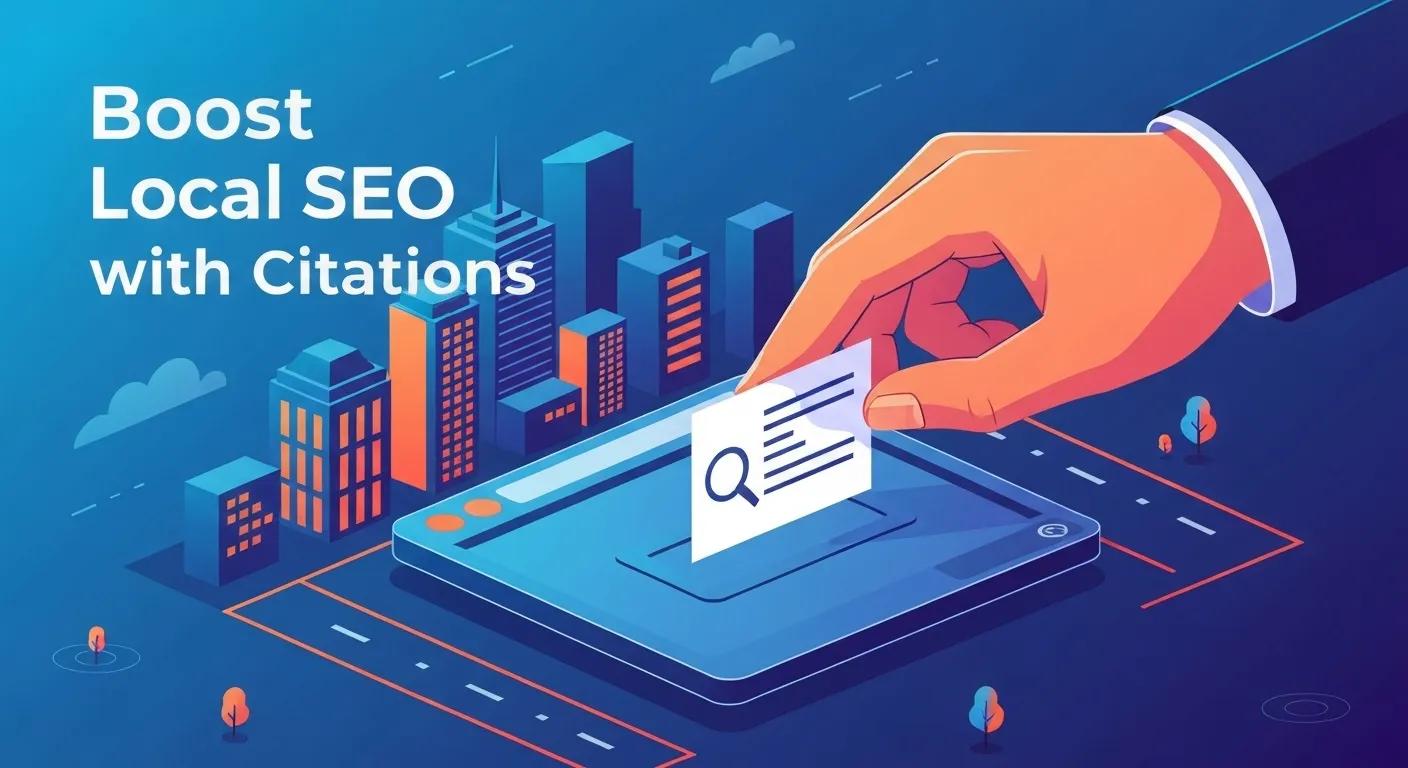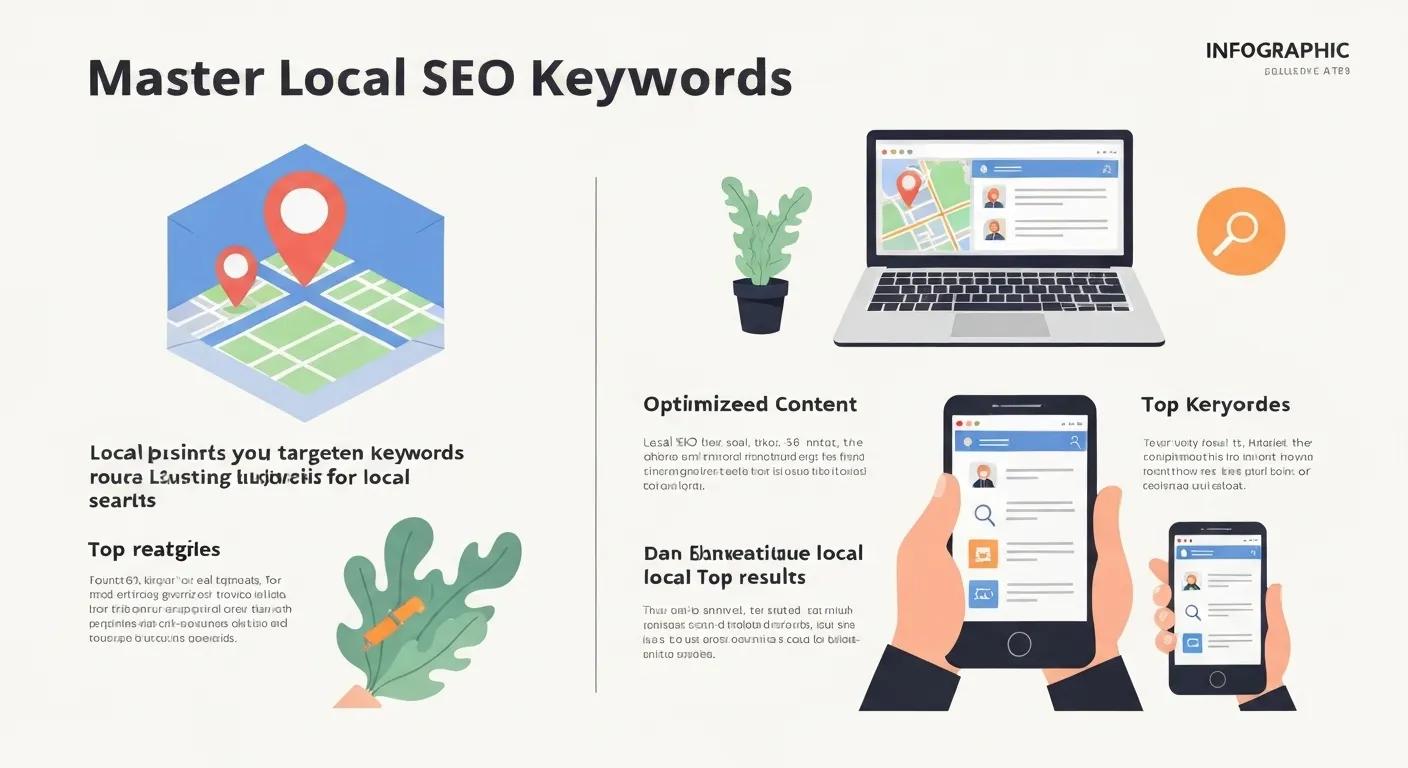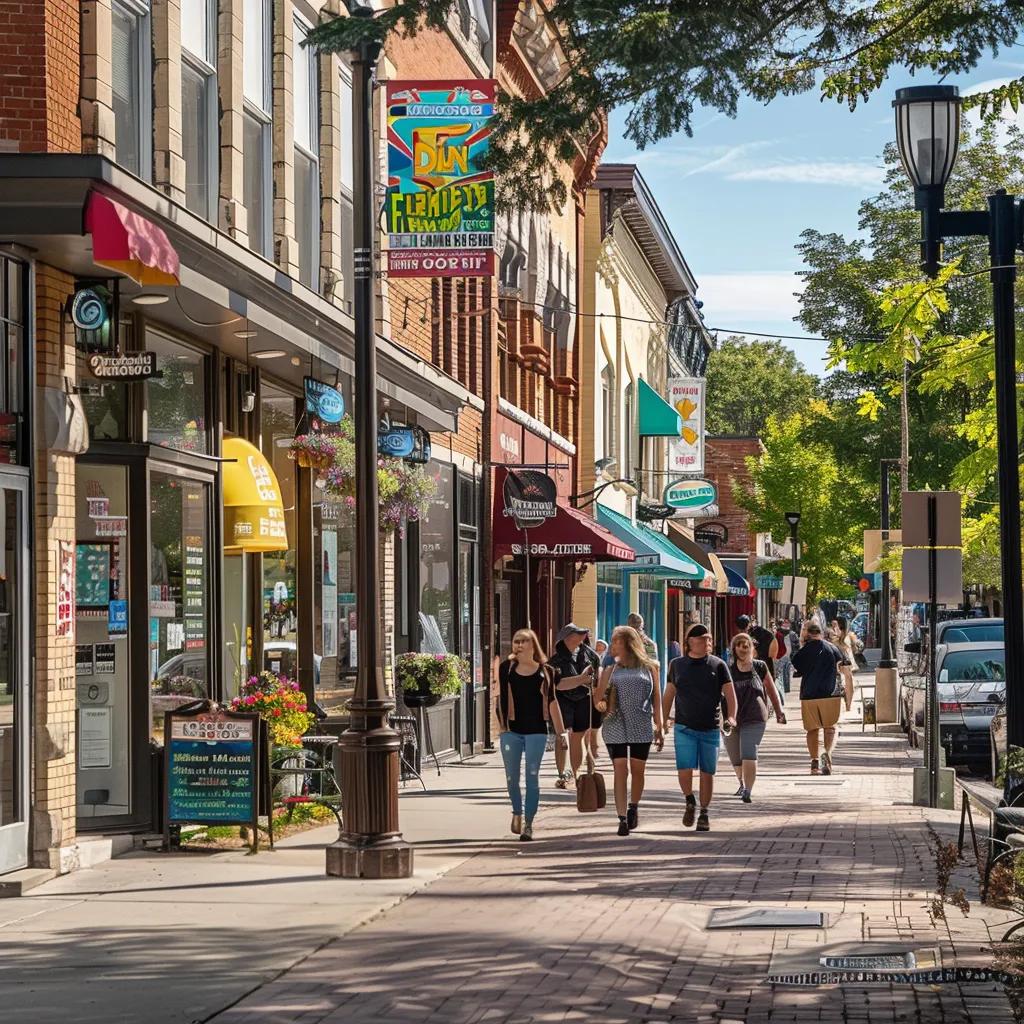The Role of Relevance in Local SEO Ranking
Relevance in local SEO means matching a searcher’s intent to the most appropriate local product, page, or business listing, and it directly influences whether local shoppers discover and buy apparel nearby. This article explains what search relevance is, how Google evaluates it alongside proximity and prominence, and why apparel brands that optimize for relevance convert local interest into measurable sales. Readers will learn concrete tactics for optimization, local content and keyword strategies tailored to clothing and accessories, reputation and citation management, advanced prominence-building techniques, and the KPIs to track apparel sales growth. The guidance focuses on practical steps e-commerce apparel teams can implement, illustrated with DockSyde Creative’s apparel examples where appropriate to show how these tactics translate into direct product purchases. By the end you’ll have a prioritized checklist and measurement framework to increase local visibility for clothing stores, improve “near me” performance, and nudge local shoppers toward buying apparel and accessories.
What Are the Key Local SEO Relevance Factors That Impact Ranking?

Relevance, proximity, and prominence form the triad that determines local search outcomes: relevance maps query intent to listing content, proximity accounts for geographic distance, and prominence reflects the listing’s authority signals. For apparel brands, relevance is demonstrated when product listings, category choices, and page content clearly match local fashion queries, while proximity matters for foot traffic or location-specific pickup options and prominence drives trust through reviews, links, and citations. Optimizing each factor requires both on-page semantic alignment and off-page reputation building so that product pages and GBP entries surface for local shoppers. The section below compares these three factors and maps apparel-specific signals to each, giving a clear EAV-style view of how to prioritize actions for clothing stores.
This comparison shows how distinct signals translate to apparel search performance and where to focus for quick wins.
| Factor | Key Signals | Apparel-specific Examples |
|---|---|---|
| Relevance | Categories, product titles, schema, page content | “Lake t-shirt” product pages, product schema with size/color attributes |
| Proximity | Distance, service area, store location | Local pickup pages, store locator entries for Traverse City neighborhoods |
| Prominence | Reviews, backlinks, citations, GBP engagement | High review volume for jackets, local partner links from event organizers |
How Do Relevance, Proximity, and Prominence Influence Local Search Results?
Relevance determines whether a listing answers the user’s query: Google evaluates product titles, descriptions, GBP categories, and structured data to match intent. Proximity is a deterministic filter for queries with local intent — users searching “near me” or with location signals will favor closer inventory or pickup options. Prominence acts as a tie-breaker: when relevance and proximity are similar across listings, prominence (reviews, links, citation breadth) pushes one result above another. For apparel brands, a relevant product listing for a local event (for example, a “Traverse City Lake Days tee”) combined with a nearby store location and strong local reviews will outperform a distant but authoritative retailer. Understanding how these three signals interplay helps brands sequence optimizations: lock in relevance first, then shore up proximity cues and finally amplify prominence.
This mechanism leads naturally to practical GBP and on-site changes you can implement immediately to increase local discoverability.
Why Is Relevance the Most Critical Factor for Local Apparel Brands?
Relevance often outweighs proximity and prominence for apparel searches because buying intent is tightly tied to product attributes — style, size, availability, and event fit — that must match the query. A shopper searching “breathable boating shirt near me” expects inventory-level cues like fabric, activity use, and local availability; if product pages and GBP products reflect those attributes precisely, conversion likelihood rises. For niche apparel—lake or boating lifestyle items—relevance aligns product language with community vocabulary and seasonal trends, producing better CTRs and faster path-to-purchase. Focusing on relevance reduces wasted ad spend and increases the efficiency of local promotions by ensuring traffic that arrives is already product-qualified.
Clarifying relevance also informs measurement: when relevance improves, you should see higher product clicks, GBP product views, and local conversion rates — metrics covered later in the measurement section.
How Does Google Interpret Local Search Ranking Signals?
Google ingests structured fields (GBP categories, product attributes, schema markup) and behavioral signals (clicks, direction requests, calls) to build a composite ranking score for local queries. Machine-processed signals like product schema and GBP attributes provide explicit context about what you sell and where, while behavioral data reveals real-world relevance and demand. For apparel stores, indexable signals include product schema (brand, size, color, availability), GBP product entries, and localized on-page content; behavior signals to prioritize are product clicks, add-to-carts from local pages, and GBP-driven direction requests. A checklist of indexable signals: product schema, GBP categories/products, NAP consistency, local landing pages, and review markup — each should be audited and implemented to ensure Google correctly interprets your apparel offerings.
These indexable improvements set the stage for building credibility through E-E-A-T, which further strengthens local relevance.
Differential Effects of Online Signals on Sales Performance of Local Brand Clothing Products
Businesses need to make quick decisions and adjustments to fulfill the growing online demand. Previous studies examined various factors affecting the online sales performance of products such as b
What Role Does E-E-A-T Play in Enhancing Local SEO Relevance?
Experience, Expertise, Authoritativeness, and Trustworthiness (E-E-A-T) strengthen relevance by signaling to search systems and users that your apparel products are reliable, high-quality, and locally credible. For apparel brands this means detailed product pages with clear sizing, materials, and fit guides (experience), staff bios or designer notes (expertise), local press mentions or partner links (authoritativeness), and abundant verified reviews and transparent return policies (trustworthiness). Localized product content that displays customer photos and event use-cases both demonstrates experience and encourages UGC that feeds prominence signals. In practice, E-E-A-T reduces friction in purchase decisions: when shoppers see authoritative product information and local customer validation, conversion rates climb.
Building E-E-A-T should be iterative: start with robust product content and structured data, then layer and local partnerships to compound authority.
How Can Google Business Profile Be Optimized to Maximize Local Relevance?
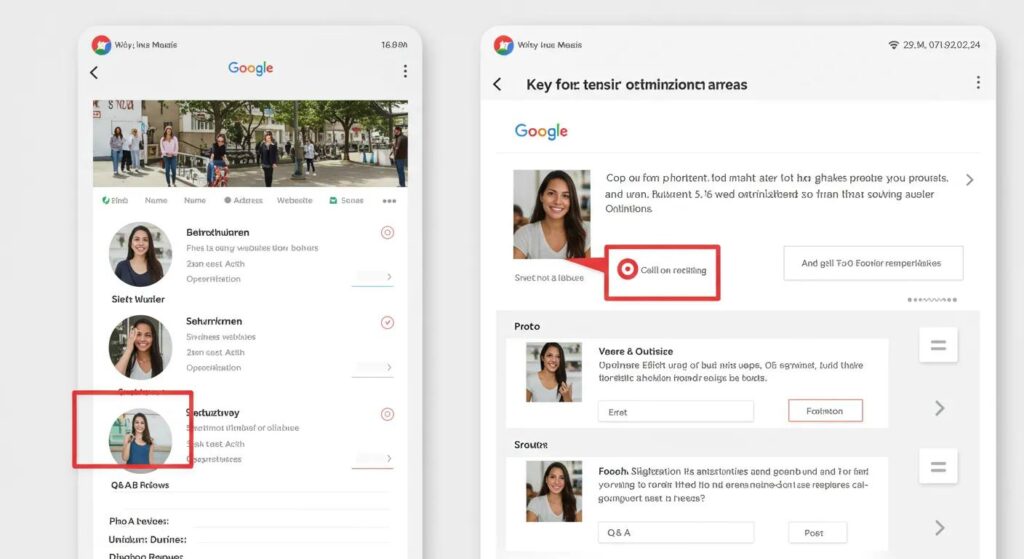
A fully optimized Google Business Profile is one of the fastest ways to surface apparel inventory to local shoppers because GBP fields are directly used in local ranking and product visibility. Prioritize precise categories, complete product listings with SKU-like details, accurate attributes that describe materials and activity (e.g., boating, outdoor), and regular GBP posts for promotions or inventory updates. High-quality photos that show products in local settings and managed Q&A entries that pre-answer sizing and shipping questions increase relevance and conversion. Below are best-practice steps you can apply immediately to align GBP with local apparel queries.
Follow this GBP checklist to ensure each field and media asset contributes to relevance and buyer confidence.
- Select precise primary and secondary categories that match your inventory and niche.
- Add GBP products with detailed titles, descriptions, price ranges, and attributes.
- Publish weekly GBP posts for events, restocks, and local promotions.
- Maintain a Q&A backlog with standardized answers for sizing, pickup, and returns.
| Product Attribute | GBP Field | Example / Best Practice |
|---|---|---|
| Category | Primary/Secondary Category | Use “Clothing Store” and niche subcategory like “Boating Apparel” if available |
| Product Details | GBP Product Title & Description | “Traverse Lake Tee — Breathable Cotton, Unisex, Sizes S–XL” |
| Availability | Product Price/Availability | “In store: Available; Online: Limited stock” |
| Photos | Image Uploads & Service Photos | Lifestyle shots at local events, alt text including location and product name |
What Are the Best Practices for Crafting Relevant Google Business Profile Descriptions?
A GBP description should define who you serve, what you sell, and where you’re local — using natural language that incorporates local modifiers without stuffing keywords. Start with a concise one-line value proposition (product + locality), follow with 2–3 sentences detailing signature product types and event ties, and close with a service-specific sentence (pickup, local shipping, returns). For example, a short variant could read as a focused local product hook, while a longer variant expands on collections and local event participation. Keep descriptions user-centered: emphasize tangible benefits like fabric performance, sizing guides, or local pickup options to align with shopper intent.
Well-crafted GBP copy improves relevance by matching both product and local intent, which leads into the tactical use of GBP posts and Q&A to surface real-time inventory and event promotions.
How Do GBP Posts and Q&A Features Boost Local Apparel Visibility?
GBP posts and Q&A let apparel brands communicate inventory updates, promotions, and event-specific collections directly in the local search experience; they also generate fresh signals that can be used by Google to determine current relevance. Use posts to highlight seasonal drops, restocks for popular sizes, and local event collections (e.g., “Lake Days Collection restock this weekend”) and include clear calls-to-action that point to product pages or in-store pickup. For Q&A, pre-seed common buyer questions about sizing, materials, and local pickup and answer them with consistent, keyword-aligned responses to reduce buyer friction. A cadence of weekly posts plus proactive Q&A management keeps the GBP listing current and increases the probability that your products will appear in local product carousels.
Regular posting and Q&A maintenance reinforce product availability signals and support conversion by reducing uncertainty about purchases.
Which Product Categories and Attributes Improve Google Business Profile Relevance?
Choosing the right GBP categories and product attributes ensures Google associates your listing with the exact apparel queries local shoppers use. Primary category should reflect your core offering (e.g., Clothing Store), with secondary categories for accessories or specialty items. Product attributes to include are material, gender targeting, activity (boating, outdoor, casual), and availability for pickup or same-day fulfillment. Map each product to clear category/attribute combinations so that inventory surfaces for relevant local searches like “boat shirt near me” or “Traverse City lake hoodie.” Use consistent naming conventions in product titles to align GBP product entries with on-site product pages and structured data.
A consistent category and attribute strategy makes your GBP product inventory findable for hyper-local, activity-specific apparel queries.
How Can High-Quality Photos and Reviews Enhance GBP Relevance?
Photos and reviews are persuasive credibility signals: images that show products worn in local contexts (events, beaches, marinas) increase click-throughs, while a steady stream of positive reviews raises prominence in local pack ties. Optimize images by using descriptive filenames and ALT text that include product names and local modifiers, and upload a mix of product shots and lifestyle photos. For reviews, encourage post-purchase customers to describe fit and local usage, then respond promptly to both praise and concerns to demonstrate service quality. Review snippets and star ratings increase CTR from SERPs and can directly influence conversions when paired with clear product availability information.
Combining optimized images with a proactive review strategy reinforces both relevance and trust, which helps apparel listings win local queries.
How to Optimize Local Content and Keywords for Apparel Brand Relevance?
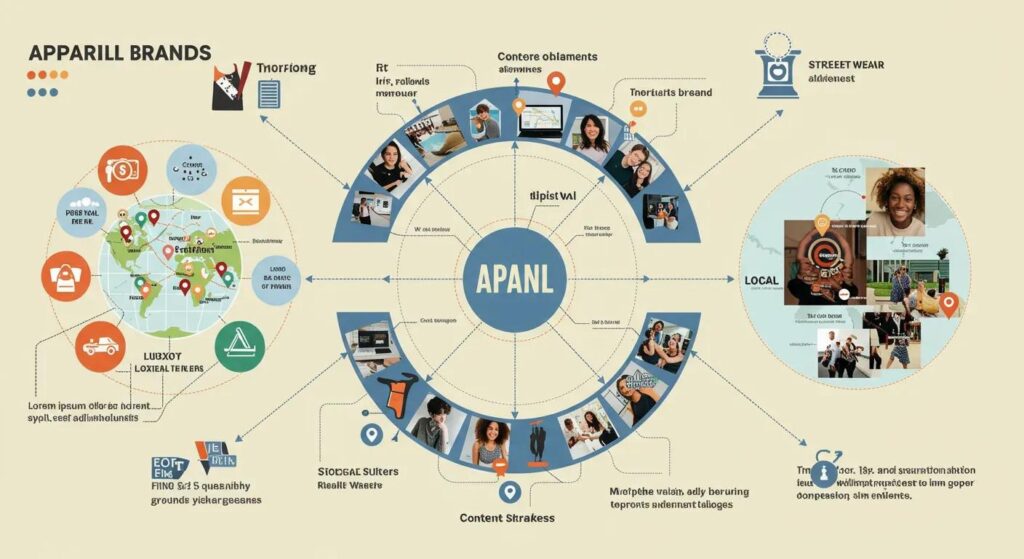
Local content optimization requires intentional keyword mapping, location-specific landing pages, and semantic content that captures lifestyle intent and event-driven searches. Start by clustering keywords into transactional (buy, order), local-intent (near me, Traverse City), and event-driven (lake days, regatta). Then map high-priority keywords to product pages, local landing pages, and blog posts that showcase local styling, event collections, and community stories. Use schema for products and local business markup for landing pages to help search engines understand inventory and locality. This approach ensures that when local shoppers search for apparel tied to place or activity, your pages and product listings appear with high relevance.
A structured keyword strategy feeds directly into content templates and on-page optimizations that convert local traffic into apparel sales.
- Local keyword strategies to implement for apparel relevance:
- Target transactional plus location modifiers (e.g., “boat shirt Traverse City”).
- Capture “near me” intent on product and store pages using local schema and copy.
- Create event-focused long-tail content around community activities and seasonal trends.
What Local Keywords Should Apparel Brands Target for Maximum Visibility?
Apparel brands should prioritize three keyword categories: transactional phrases with product intent, local modifiers that signal proximity, and event-specific queries that show immediate buying intent. Examples include “lake tee near me,” “Traverse City boating shirts,” and “lake festival hoodies pickup.” Place high-intent transactional phrases on product titles and meta tags, local modifiers on landing pages and GBP content, and event-driven terms in blog posts and collection pages. Long-tail phrases combining product, activity, and location often convert best because they match precise buyer intent and competitive density is lower.
Targeting this mix of keywords ensures visibility across the buyer journey from discovery (event guides) to conversion (product pages).
How to Create Location-Specific Content That Drives Local Apparel Sales?
Location-specific content converts local interest by telling a place-based story and making purchase actions obvious: create local landing pages that highlight inventory available for pickup, reference nearby landmarks and events, and include local sizing or weather-based styling advice. Use customer photos, UGC, and event coverage to demonstrate real-world usage and incorporate calls-to-action for in-store pickup or limited local drops. An effective local product page template includes a short local lead, product benefits tied to local activities, availability info, and bright CTAs for pickup or shipping. Content that ties product utility to the local lifestyle reduces hesitation and increases conversions.
Local storytelling plus clear transactional cues turns search visitors into buyers by connecting product benefits to place-specific needs.
How Does Semantic Content Help Capture “Near Me” Apparel Searches?
Semantic content uses entities, related phrases, and schema to broaden relevance beyond exact-match keywords so “near me” queries find the best local product match. For apparel, semantic phrases might include activity words (boating, lake, summer), material descriptors (quick-dry, breathable), and community terms (Traverse City, marina district). Implement Product and LocalBusiness schema on product and landing pages, include related entity terms naturally in copy, and create content clusters around entity relationships (product → activity → event). This semantic graph helps search engines connect a “near me” apparel query to your inventory even when keyword phrasing differs.
Semantic optimization increases the chance that local intent queries match your product catalog by mapping real-world relationships between product attributes and local contexts.
What Are Effective Strategies for Integrating Local Events and Trends into Apparel Content?
Tie apparel promotions to local events and seasonal trends through dedicated collections, event landing pages, and limited-time GBP posts. Create calendar-driven content: pre-event styling guides, countdown posts for restocks, and post-event galleries featuring attendees wearing your brand. Partner with local organizers for co-branded promotions and cross-promote via social channels to generate UGC and backlinks. Seasonal capsule collections framed around local events (for example, a lake-days collection) create urgency and align search intent with inventory availability.
Event integrations convert local interest into urgency-driven purchases and produce shareable content that strengthens both relevance and prominence.
How Do Online Reviews and Citations Build Trust and Local Relevance for Apparel Brands?
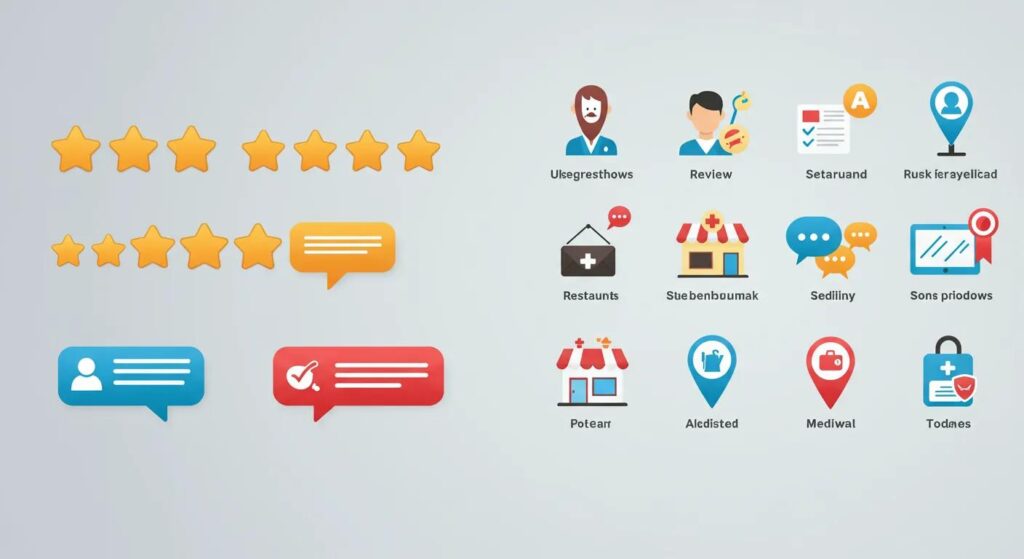
Reviews and citations are cornerstone reputation signals that directly influence local rankings and buyer trust: consistent validate location data while reviews demonstrate product quality and service. For apparel retailers, a steady cadence of authentic product reviews—especially those mentioning fit, material, and local use—signals relevance to shoppers and search engines. Citations across local directories, event pages, and tourism listings expand discoverability and provide contextual backlinks. Reputation work should be systematic: solicit reviews, respond promptly, and audit citation consistency to ensure NAP accuracy across major directories and local resources.
Below are practical review and citation tactics that translate directly into improved local visibility and purchase intent.
- Request reviews via post-purchase emails and SMS within a recommended window after delivery.
- Maintain NAP consistency across major directories and local partner pages.
- Respond to all reviews with a standardized tone that addresses concerns and invites next steps.
What Are the Best Methods to Generate and Manage Local Apparel Reviews?
Generate reviews by timing requests after delivery or a local event when the purchase experience is fresh, and personalize outreach to highlight product fit and event usage. Use a simple review funnel: purchase confirmation → delivery email with review request → follow-up reminder that includes prompts (fit, material, occasion). For management, monitor review platforms and aggregate feedback into product improvements and FAQ updates. Response templates should thank positive reviewers and offer solutions for negative feedback while directing users to local pickup or exchange options where applicable.
A predictable review funnel and consistent response approach increases review volume and demonstrates service responsiveness to potential buyers.
Why Is NAP Consistency Vital for Local SEO Relevance?
Name, Address, Phone (NAP) consistency helps search engines verify your business identity across the web; discrepancies create confusion that can hurt local rankings and visibility. Apparel brands must ensure the same business name variant, address format, and phone number appear on GBP, local directories, event pages, and supplier listings. Audit top directories, local chambers, and event partner pages for mismatches and correct them systematically. Use a simple checklist to log sources, current values, and correction status to maintain consistency across the local ecosystem.
Reliable NAP data stabilizes local relevance signals and improves the chance that product-specific queries resolve to your listings.
How Do Local Citations Strengthen Brand Authority and Relevance?
Local citations on tourism sites, event pages, and industry directories create contextual relevance and often supply valuable backlinks that enhance prominence. Citations that include product mentions or links to location-specific landing pages are especially effective for apparel brands targeting regional shoppers. Prioritize citations on high-relevance local sources—event calendars, chamber directories, and community guides—and seek co-marketing opportunities that naturally place your product offerings within local narratives. The combined effect is increased local authority and more entry points for customers to find product pages.
Citations, when consistent and context-rich, extend your apparel brand’s local footprint and contribute to higher local pack rankings.
How Can Positive Reviews Influence Local Search Click-Through Rates?
Star ratings and review snippets improve perceived trust and relevance, often boosting click-through rates from local packs and organic results; higher CTRs typically translate to more product page visits and transactions. To surface review stars in SERPs, ensure review schema is implemented on product pages and structured correctly. Responding to reviews enhances the content available for snippets and can increase the likelihood of rich result display. A deliberate strategy of collecting descriptive local reviews (mentioning product, fit, and local use) amplifies CTR because searchers see evidence that the item is both relevant and locally trusted.
Higher CTRs from review-enhanced listings are measurable: track CTR shifts after review campaigns to attribute their impact on local apparel sales.
What Advanced Strategies Enhance Prominence and Authority for Local Apparel SEO?

Once relevance is established, scale prominence through local link building, social engagement, partnerships, and data-driven experimentation. Local link sources—press coverage of events, sponsorship pages, and partner directories—signal regional authority. Social campaigns that encourage UGC and tie to local hashtags amplify discoverability and feed GBP posts and product pages. Use AI tools and heatmap ranking reports to find gaps in product visibility and to prioritize optimizations for high-impact items. These advanced strategies convert local awareness into measurable traffic and links that improve long-term rankings.
Below are prioritized actions to build sustainable local prominence for apparel brands.
- Earn local backlinks through event sponsorships, guest posts on community blogs, and collaborations with local organizations.
- Run localized social campaigns and UGC contests tied to events to generate content and backlinks.
- Use heatmaps and intent clustering to optimize product titles and GBP posts for queries with conversion potential.
How Does Local Link Building Improve Apparel Brand Prominence?
Local link building focuses on relevant, authoritative local sources such as event organizers, tourism boards, local news outlets, and community blogs. Tactics include sponsoring events with co-branded pages, pitching seasonal apparel features to local press, and collaborating with complementary local businesses for shared landing pages. Prioritize link opportunities by domain relevance and referral traffic potential, and track impact through organic local rank and referral visits. High-quality local links not only drive direct referral traffic but also signal to search engines that your apparel offerings matter to the local community.
Consistent outreach and relationship-building create link pipelines that deliver both reputation and measurable traffic gains.
What Role Does Social Media Engagement Play in Local SEO Relevance?
Social campaigns that highlight local events, customer stories, and product use cases increase brand recognition and generate signals that support local discovery. Encourage local UGC by running photo contests tied to events and promote GBP posts through social channels to drive direct engagement. While social signals are indirect ranking factors, the content and links generated from social campaigns frequently lead to citations, backlinks, and increased search demand that boost local prominence. Measure campaign success via engagement, UGC volume, and resulting referral traffic to product pages.
Social engagement is a multiplier: it creates assets that feed GBP, on-site content, and local partnerships for greater visibility.
How Can Community Partnerships and Events Boost Local Apparel Visibility?
Partnering with local events and organizations places apparel products directly in front of engaged audiences and often yields citations, links, and co-marketing exposure. Examples include curating event-specific collections for local festivals, supplying branded apparel for volunteers, and hosting pop-up shops at community gatherings. These activities produce press mentions, directory listings, and social shares that accelerate prominence while creating immediate opportunities for sales. Coordinate with partners to ensure product and brand details are accurately listed and linked back to local landing pages.
Event-driven partnerships generate short-term revenue and long-term authority that together strengthen local SEO for apparel brands.
How to Leverage AI and Data-Driven Insights for Apparel Local SEO Optimization?
AI and data tools help identify high-intent local queries, prioritize product optimizations, and automate repetitive on-page tasks. Use intent clustering to discover niche local phrases, apply heatmap ranking reports to see geographic visibility gaps, and run AI-assisted tests for product titles and GBP posts. Structure experiments with clear hypotheses (e.g., adding “Traverse City” to product titles increases local product views), control variants, and measurable metrics like GBP product views or local conversion rate. AI can also surface semantic phrases and content templates that improve relevance while saving editorial time.
A disciplined, data-driven approach ensures optimizations focus on product and page changes that materially improve local sales.
How to Measure and Track Local SEO Relevance for Apparel Sales Growth?
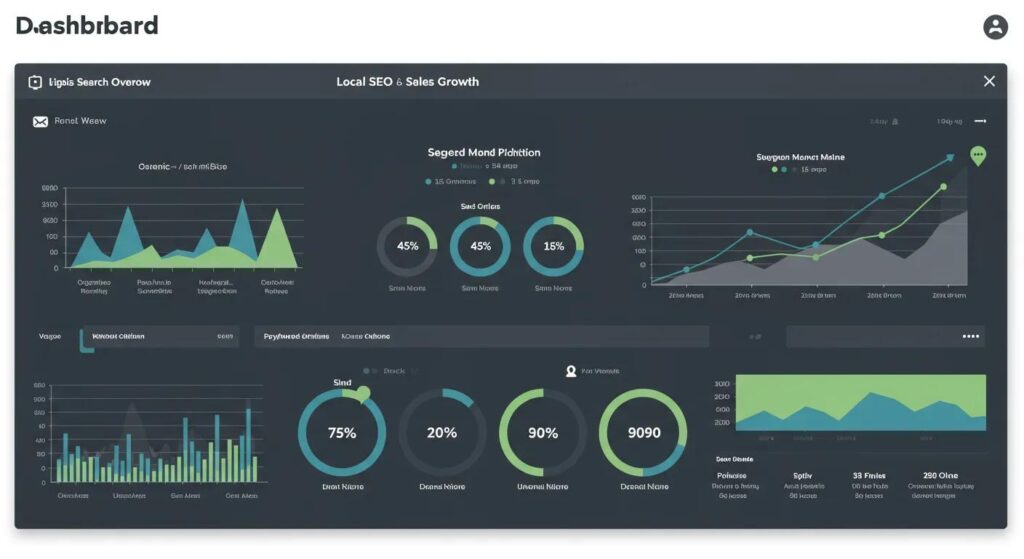
Measuring local SEO requires tracking a blend of ranking, engagement, and sales KPIs: local pack rank for target keywords, GBP views and product interactions, local organic traffic, direction requests, and conversion signals tied to product purchases or local pickup. Build a dashboard that correlates GBP product views and local landing page sessions with on-site conversion metrics to attribute sales to local search activity. Heatmap ranking reports and intent clusters reveal which products are underperforming locally and where to focus optimizations. Regular A/B tests on product titles, GBP posts, and local page headlines provide iterative evidence of what lifts relevance and conversions.
Next are recommended KPI definitions, data sources, and sample targets to anchor measurement.
| KPI | Metric Source | Example Target / Interpretation |
|---|---|---|
| Local Pack Rank | Local rank tracking tool | Top 3 for 5 priority local product queries |
| GBP Product Views | Google Business Profile Insights | 20% month-over-month increase after product sync |
| Direction Requests | GBP Insights | 10–15 direction requests/month indicating foot traffic |
| Local Conversion Rate | GA4 geo-segmented ecommerce | 2–4% on local landing pages, increasing with relevance tweaks |
What KPIs Best Reflect Local SEO Relevance Impact on Apparel Sales?
Primary KPIs include local pack rankings for product queries, GBP product views and clicks, local organic sessions to product pages, and conversion rates for geo-segmented traffic. Secondary KPIs are review volume and sentiment, citation reach, and backlink acquisition from local sources. Track month-over-month trends and attribute sales lifts through UTM tagging on local campaigns and GA4 geo-segmentation to isolate local traffic. Interpreting these KPIs together reveals whether relevance changes are producing more qualified local traffic and higher conversion efficiency.
A balanced KPI set prevents overfocusing on rank alone and ties local SEO work to tangible apparel revenue.
How to Use Google Business Profile Insights to Monitor Local Engagement?
GBP Insights surfaces views, searches, actions (calls, direction requests), and product-specific interactions; these metrics correlate closely with local buyer interest and can be used to prioritize product restocks and promotions. Monitor which GBP products receive the most views and clicks and align inventory decisions or promotions with those signals. Use GBP action trends to infer funnel stages—high product views with low clicks may indicate listing copy issues, while high direction requests signal strong intent to visit. Regular GBP reporting enables rapid adjustments to product listings, photos, and posts to maximize local conversions.
Mapping GBP signals to on-site behavior closes the loop between discovery and purchase for local apparel shoppers.
How Can Heatmap Ranking Reports Inform Apparel Product Visibility?
Heatmap ranking reports visualize where product queries perform strongly or weakly across a geographic area, revealing neighborhoods or micromarkets with untapped demand. For apparel brands, heatmaps can show that certain products rank well in one part of a city but poorly in another, guiding targeted GBP posts, local landing pages, or pop-up events. Use heatmap insights to prioritize product title tweaks and localized promos that close visibility gaps. Iterative use of heatmaps combined with A/B tests helps identify the specific changes that improve product-level local rank and visibility.
What Are Effective A/B Testing Methods for Local SEO Strategies?
Design local SEO A/B tests with a clear hypothesis, a single variable change (product title, GBP post content, landing page headline), a primary metric (GBP product views or local conversion rate), and a fixed duration based on traffic volumes. Maintain comparable control and variant pages or listings and use geo-targeting where possible to avoid cross-contamination. For product-focused tests, measure product page CTR and add-to-cart rate; for GBP tests, measure product views and direction requests. Use statistical thresholds for significance and iterate quickly on winners.
A robust testing framework ensures local optimizations are evidence-based and scalable.
What Are Common Questions About the Impact of Relevance on Local SEO Ranking?
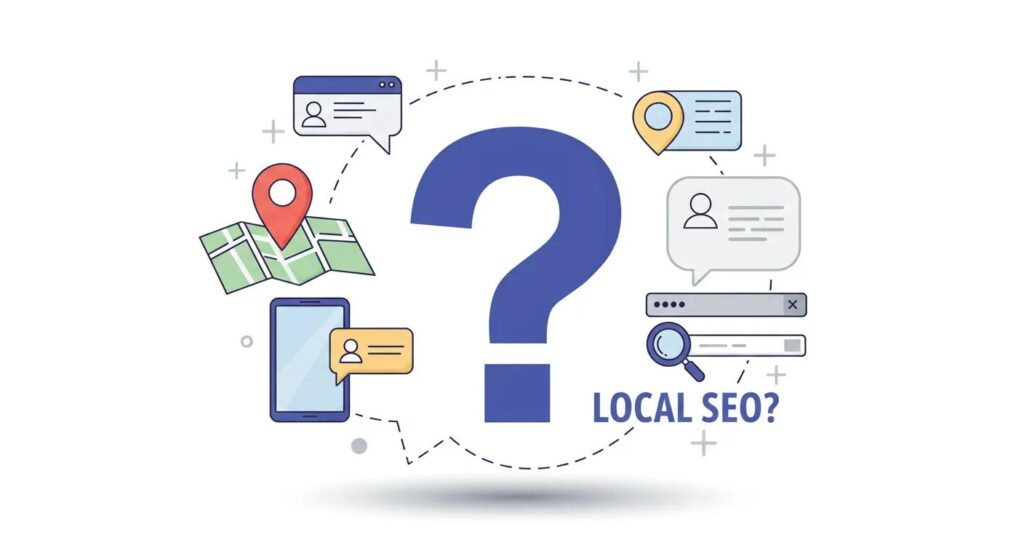
This last section answers common PAA-style queries to clarify immediate actions and expectations for apparel brands seeking local visibility improvements. Short, focused responses help users find quick guidance on relevance impact, top ranking factors, and practical first steps for brands like that sell apparel and accessories.
How Does Relevance Impact Local SEO for Apparel Brands?
Relevance impacts discovery and conversion by ensuring product listings and pages match the shopper’s intent for style, activity, location, and availability. When apparel content—product titles, GBP products, and local landing pages—uses the same language customers use, search engines and shoppers are more likely to connect, resulting in higher product clicks and conversion rates. For example, including activity terms like “boating” or a local modifier like “Traverse City” in product titles and GBP entries increases the likelihood of appearing for “near me” and event-driven apparel queries. Improving relevance therefore directly increases qualified local traffic and sales.
What Are the Most Important Local SEO Ranking Factors for Clothing Stores?
The top local ranking priorities for clothing stores are relevance (product and page alignment), proximity (store or pickup options), and prominence (reviews, links, citations). Actionable items include accurate GBP categories and product listings for relevance, clear store location and pickup information for proximity, and a steady stream of local reviews and citations for prominence. Prioritize product schema, GBP product entries, and review generation to get the most tangible near-term lift in local apparel visibility.
How Can DockSyde Apparel Improve Its Google Business Profile Relevance?
DockSyde Creative can improve GBP relevance by adding product-level entries for apparel and accessories, using precise category selection, uploading lifestyle photos featuring local events, and maintaining regular GBP posts announcing restocks and local drops. Quick wins include ensuring product titles incorporate local modifiers and activity descriptors, and proactively answering common sizing and pickup questions in the Q&A section. These steps make DockSyde’s apparel more discoverable for local shoppers and support the goal of driving direct sales of apparel and accessories.
Is Local SEO Still Relevant for Apparel E-commerce in 2025?
Yes — local intent remains a significant driver of mobile and transactional searches in 2025, and apparel e-commerce benefits when brands align product content with local queries and provide clear local fulfillment options. Recent behavior trends show shoppers increasingly look for locally available products and event-driven apparel, and optimizing for local relevance reduces friction between discovery and purchase. Apparel retailers should prioritize GBP product listings, semantic on-site content, and review/citation management to capture local demand and convert it into sales.
For brands focused on driving direct apparel sales, these local SEO tactics are practical, measurable, and immediately actionable. If you want to see how these strategies work in practice, consider exploring DockSyde Creative’s apparel and accessories to observe local product listings, GBP product examples, and event-driven collections that put these principles into action.
Frequently Asked Questions
What are the benefits of optimizing for local SEO in the apparel industry?
Optimizing for local SEO in the apparel industry enhances visibility among local shoppers, leading to increased foot traffic and online sales. By ensuring that product listings align with local search intent, brands can attract customers looking for specific items nearby. This optimization also improves the chances of appearing in local search results, which is crucial for driving conversions. Additionally, local SEO helps build brand authority through positive reviews and citations, fostering trust among potential customers and encouraging repeat business.
How can apparel brands effectively manage online reviews?
Apparel brands can manage online reviews by implementing a systematic approach to solicit feedback from customers post-purchase. This can include sending follow-up emails or SMS messages requesting reviews shortly after delivery. It’s essential to respond to all reviews, both positive and negative, to demonstrate customer service quality. Brands should also analyze feedback to identify areas for improvement in products and services. Encouraging customers to mention specific attributes like fit and local usage can enhance the relevance of reviews for local SEO.
What types of local content should apparel brands create?
Apparel brands should create location-specific content that resonates with local shoppers. This includes local landing pages that highlight inventory available for pickup, styling guides based on local weather, and event-driven content that ties products to community activities. Additionally, brands can feature customer stories and user-generated content that showcase real-world product usage. By integrating local keywords and community references, this content can improve search visibility and drive local traffic to product pages.
How can social media enhance local SEO for apparel brands?
Social media can significantly enhance local SEO for apparel brands by increasing brand visibility and engagement within the community. Running campaigns that encourage user-generated content, such as photo contests tied to local events, can generate buzz and backlinks. Sharing local event participation and product highlights on social platforms can drive traffic to Google Business Profiles and product pages. Engaging with local customers through social media also fosters community relationships, which can lead to increased trust and loyalty, further boosting local SEO efforts.
What role do local partnerships play in boosting apparel visibility?
Local partnerships can greatly enhance apparel visibility by placing products in front of engaged audiences at community events. Collaborating with local organizations for co-branded promotions or sponsoring events can generate valuable backlinks and citations. These partnerships often lead to press mentions and social shares, which amplify brand awareness. Additionally, featuring products in local events creates immediate sales opportunities and strengthens the brand’s local authority, making it more relevant in local search results.
How can apparel brands track the effectiveness of their local SEO efforts?
Apparel brands can track the effectiveness of their local SEO efforts by monitoring key performance indicators (KPIs) such as local pack rankings, Google Business Profile views, and conversion rates from local traffic. Utilizing tools like Google Analytics and GBP Insights allows brands to analyze user interactions and identify trends. Regularly reviewing these metrics helps brands understand which strategies are driving traffic and sales, enabling them to make data-driven adjustments to their local SEO tactics for continuous improvement.
What are some common mistakes to avoid in local SEO for apparel brands?
Common mistakes in local SEO for apparel brands include neglecting Google Business Profile optimization, failing to maintain NAP (Name, Address, Phone) consistency, and not actively managing online reviews. Additionally, brands may overlook the importance of local keywords and content that resonates with the community. Another mistake is not leveraging local events and partnerships to enhance visibility. Avoiding these pitfalls requires a proactive approach to local SEO, ensuring that all aspects of the brand’s online presence align with local search intent.



